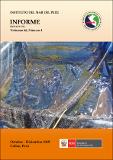Por favor, use este identificador para citar o enlazar este ítem:
https://hdl.handle.net/20.500.12958/3380| Título : | Caracterización de recursos bentónicos en las islas Guañape (Norte y Sur), La Libertad – 2016 |
| Otros títulos : | Characterization of benthic resources in the Guañape islands (north and south), La Libertad – 2016 |
| Autor : | Alfaro Mudarra, Santos De Lucio Burga, Luis Escudero Herrera, Luis Atoche Suclupe, Dennis Flores León, Lorenzo Goicochea Vigo, Carlos Campos Rivas, Martín García Tello, Oscar Neira Mendoza, Úrsula |
| Palabras clave : | Caracterización de los recursos bentónicos de importancia comercial y ecológica;Calidad Ambiental;Islas Guañape |
| Fecha de publicación : | 2019 |
| Editorial : | Instituto del Mar del Perú |
| Citación : | Inf Inst Mar Perú 46(4), 2019, p.601-635 |
| Citación : | Informe IMARPE;46(4), 2019 |
| Resumen : | Se realizó la caracterización de los recursos bentónicos de importancia comercial y ecológica que
habitan las islas Guañape Norte y Sur, así como el estado del ambiente en que se desarrollan. Se efectuaron
29 estaciones de muestreo en el intermareal y submareal, mediante buceo autónomo. Se tomaron en cuenta
los datos de abundancia por grupos, composición a nivel de género y datos oceanográficos (temperatura,
salinidad). Los resultados indican que los recursos de importancia comercial se encuentran mermados
en biomasa y densidad, con elevados porcentajes de ejemplares con tallas inferiores a la Talla y Peso
Mínimo de Captura. Las especies estructuradoras del sistema de islas de Guañape fueron: Semimytilus
algosus, Owenia sp., Chaetopterus variopedatus, Balanus laevis y Austromegabalanus psittacus, mientras que
la predominante abundancia de Alia unifasciata es un buen indicador biológico de la perturbación de la
diversidad en el estrato de 10 m de profundidad de isla Guañape Sur. El medio ambiente marino en la zona
estuvo influenciado por el evento El Niño 2015-2016. ABSTRACT:The characterization of the benthic resources of commercial and ecological importance that inhabit the North and South Guañape Islands was carried out, as well as the environmental state in which they are developed. There were 29 sampling stations in the intertidal and subtidal, by means of autonomous diving. Data on abundance by group, gender composition, and oceanographic data (temperature, salinity) were taken into account. The results indicate that commercially important resources are depleted in biomass and density, with high percentages of specimens with sizes smaller than the Size and Minimum Catch Weight. The structuring species of the Guañape island system were: Semimytilus algosus, Owenia sp., Chaetopterus variopedatus, Balanus laevis, and Austromegabalanus psittacus, while the predominant abundance of Alia unifasciata is a good biological indicator of diversity disturbance in the 10-m depth stratum of South Guañape island. The marine environment in the area was influenced by the El Niño 2015-2016 event. |
| URI : | https://hdl.handle.net/20.500.12958/3380 |
| ISSN : | 0378-7702 |
| Aparece en las colecciones: | Informe vol. 46(4) 2019 |
Ficheros en este ítem:
| Fichero | Descripción | Tamaño | Formato | |
|---|---|---|---|---|
| Informe 46(4)-6.pdf | 3,8 MB | Adobe PDF |  Visualizar/Abrir |
Este ítem está sujeto a una licencia Creative Commons Licencia Creative Commons

